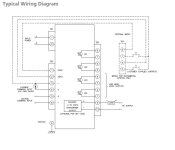I am having a incredible time understanding the attached drawing and the theory of operation on a Jordan Controls SM-1020-D-2 damper.
TB 2 terminals 3 and 4 is suppose to have 4-20 ma going to TB3 terminals 5,6, 7, and 8. TB 3 terminals 9 and 10 are the feedback 4-20 ma. I do not get
any 4-20 ma feedback with the present setup unless I place a 4-20 ma calibrator TB 2 terminals 3 and 4. What do you think influences terminal 3 - .
Would anybody know the theory of operation for this circuit ? I just cannot put my head around it.
Thanks in advance,

TB 2 terminals 3 and 4 is suppose to have 4-20 ma going to TB3 terminals 5,6, 7, and 8. TB 3 terminals 9 and 10 are the feedback 4-20 ma. I do not get
any 4-20 ma feedback with the present setup unless I place a 4-20 ma calibrator TB 2 terminals 3 and 4. What do you think influences terminal 3 - .
Would anybody know the theory of operation for this circuit ? I just cannot put my head around it.
Thanks in advance,




